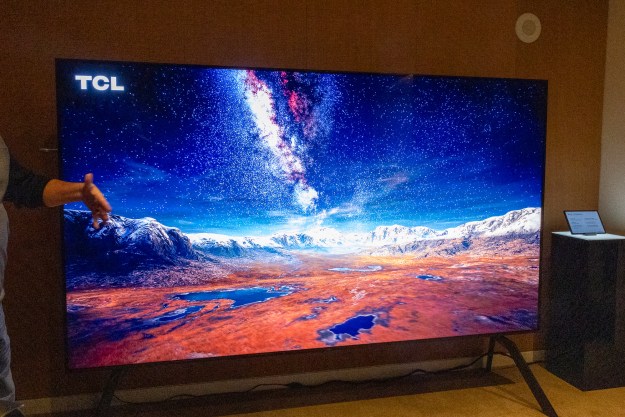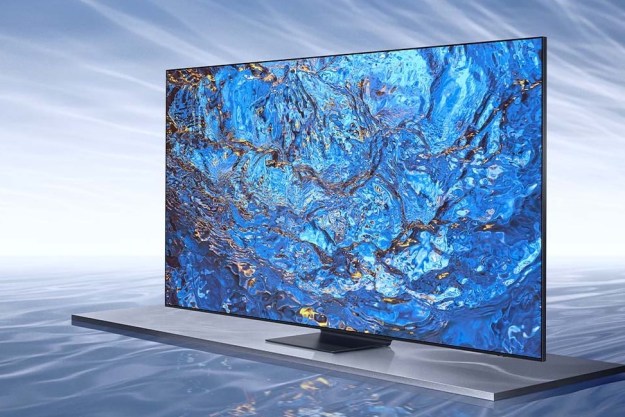At IFA 2014 in Berlin today, LG unveiled its latest effort in Ultra High Definition television, a 98-inch 8K TV (7680 x 4320 pixels) boasting 16 times the resolution of a normal 1080p HD television and four times that of the latest 4K sets that few people own yet.
That’s right: With consumers only beginning to get their heads wrapped around the notion of 4K Ultra HD TVs, and 4K content just beginning to come available, LG is pushing the edge of the tech envelope in preparation of unleashing 8K televisions on the masses in the not-too-distant future. And that suits us just fine, because this TV is absolutely stunning to behold.
The level of detail this TV was producing is hard to overstate. Pixels were all but invisible from as close at 6 inches, and completely invisible from 3 feet. The result is a picture that comes as close to reality as we’ve ever seen, due in no small part to the sense of depth that is created by the intense resolution. For the first time upon approaching a TV, we weren’t entirely certain it wasn’t a framed work of art. After a few moments of watching moving footage, we were sold. LG’s pride and joy is delicious eye candy, pure and simple.
Related: Panasonic’s new 85-inch TV is just icing on its 4K UHD cake
To be clear, this isn’t the first time we’ve seen an 8K TV in action. Digital Trends covered Sharp’s 85-inch 8K prototype at CES 2012, and Panasonic made a huge splash with its 145-inch 8K plasma TV at IFA 2012. Since then,we’ve seen a few more prototypes; Samsung, for instance showed a 98-inch 8K TV at CES 2014 and may well show it again here at IFA 2014. What makes LG’s foray into 8K so notable, however, is that it has demonstrated a commitment to helping push the industry to hasten innovation. You can be sure that when LG senses the market is approaching readiness for 8K, it will start turning out super-premium models for affluent early adopters.
The thing is, the market is not ready for 8K television, and neither is the film or broadcast industry — 8K is still years away. It was just a few days ago that Japan, a country which has always been at the forefront of Ultra high-resolution TV technology, confirmed its timetable for 4K broadcast deployment. According to Advanced Television, Japan will begin 4K satellite broadcast tests in earnest in 2016, right around the Summer Olympics in Rio de Janeiro. By 2018, 6 broadcasters in total are expected to be broadcasting a dedicated 4K channel.

Pay-TV operators in the US aren’t much further along. In order for 4K channels to offer an appreciable benefit over 1080p channels, they’ll need to free up some bandwidth. Ditching SD stations would help, but that wouldn’t be enough.
Then again, with Netflix already streaming some 4K content options and Amazon Prime Instant video (among others which have not yet been announced) soon to do the same, perhaps the future of 4K, and, by extension, 8K, doesn’t lay in the hands of the old-school broadcasters. Instead, it could lay in the hands of broadband Internet providers, which are still struggling to support consistent 4K streaming to the few people who have it.
Related: Everything you need to know about Ultra HD 4K TVs
Meanwhile, content creators like Sony and NHK will forge ahead. NHK already has an 8K camera in action, and rumor has it the company has been busy recording 8K footage. Sony and Red Digital Cinema Cameras are also rumored to be working 8K sensors and cameras. For now, the real advantage to filming in 8K is sharper, richer 4K images. But with 8K cameras on the horizon, 8K televisions can’t be far behind, and LG’s latest bombshell is evidence of that.
Editors' Recommendations
- Best Samsung TV deals: Save on 4K TVs, QLED TVs, OLED TVs, 8K TVs
- Best 8K TV deals: Samsung and LG starting at $2,500
- LG TV deals: Get a 70-inch 4K TV for under $650
- This 75-inch 4K TV from LG has a price cut from $980 to $647
- The best 8K TVs for 2024: from Samsung, LG, and Sony




